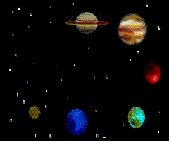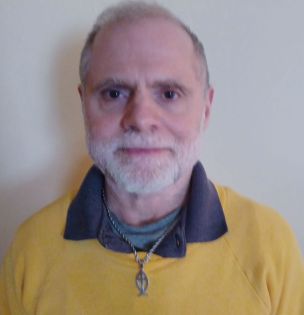Darkness to Light
Home Page
Books and eBooks by the Director
Science
and the Bible
By
Gary F. Zeolla
Does modern-day science prove the Bible is false? Many today
seem to think so. But an even a more pertinent question is,
"CAN science prove the Bible is false?" A study of the
history and nature of science is needed to answer these
questions.
The Copernican
Revolution
Throughout the Middle Ages, it was generally believed the
earth was the center of the universe (geocentricism). But then
Copernicus (1473-1564) theorized the sun was the center of our
solar system (heliocentricism). Later, Galileo (1564-1642)
utilized the newly invented telescope to verify Copernicus'
theory.
But, in 1632, Galileo was tried by the Inquisition and forced
to recant this view. Galileo's and Copernicus' writings were
placed on the Index of forbidden books by the Roman Catholic
Church (Moyer, pp.102, 155). Thus the Bible was standing in the
way of scientific progress. Right? Well, not exactly.
 A debate between
geocentrists and heliocentrists occurred throughout ancient
times. Plato (427-347 BC) initially believed in geocentricism but
in old age changed to the heliocentric theory. "But then
common sense and the authority of Aristotle (384-322 BC)
convinced the majority the sun circles around the earth."
A debate between
geocentrists and heliocentrists occurred throughout ancient
times. Plato (427-347 BC) initially believed in geocentricism but
in old age changed to the heliocentric theory. "But then
common sense and the authority of Aristotle (384-322 BC)
convinced the majority the sun circles around the earth."
Later, Egyptian astronomer Ptolemy (c. 150 AD) worked out a
complex system of "cycles, epicycles and excentrics"
which rather accurately predicted the movements of the planets
based on the geocentric theory. Geocentricism thus became the
accepted scientific theory of the Middle Ages (Clark, Thales,
pp. 305,306).
In the 1200s, the writings of Aristotle became available to
the "schoolman" (Catholic theologians). The most
notable of these was Thomas Aquinas (1225-1274).
Aquinas attempted to merge the theology of the Roman Catholic
Church with the ideas of Aristotle. As a result, "By some
schoolman, Aristotle was considered as of almost equal authority
with the church Fathers" (Moyer, pp.16,17).
Francis Schaeffer explains the result of this synthesis:
When the Roman Church attacked Copernicus and Galileo, it was
not because their teaching actually contained anything
contrary to the Bible. The church authorities thought it did,
but that was because Aristotelian elements had become part of
church orthodoxy, and Galileo's notions clearly conflicted
with them. In fact, Galileo defended the compatibility of
Copernicus and the Bible, and this was one of the factors
which brought the trial (Schaeffer, p.156).
Historian Herbert Butterfield similarly writes, "... the
Aristotelian view of the universe had become entangled with
Christianity more closely than necessity dictated." And he
attributes Galileo's condemnation to the "anti-Aristotelian
argument" in Galileo's book, The Two Principal
World-Systems (Butterfield, pp.56,68).
So the controversy surrounding the "Copernican
revolution" was NOT "the Bible vs. science" - it
was Aristotelian science (which had been merged with the Bible)
vs. the "new" science. The real culprit was the
changing nature of medieval science.
But modern-day science is more stable and reliable. Right?
Well ....
Which
Evolution?
Biologist Francis Hitching opens his book The Neck of the
Giraffe by writing, "Evolution of life over a very long
period of time is a fact.... the probability that evolution has
occurred approaches certainty in scientific terms" (p.4).
The cry, "Evolution is a fact!" is heard from many
other quarters today. But when someone makes such a claim, the
first question that needs to be asked is, "Which evolution
is it that you are declaring to be a fact?"
There are many different evolutionary theories. The one that
is most commonly known is "Darwinism." This is the form
of evolution proposed by Charles Darwin in his book The
Origin of Species, first published in 1859.
Darwin put forth the hypothesis that the various species and
varieties of animals and plants seen today evolved gradually over
eons of time. Minor changes over time gradually changed one
species or type of organism into another. "Natural
selection" determined the course of the changes.
But many scientists today do not agree with Darwin. In fact,
the above mentioned book spends the first four chapters
demonstrating the impossibility of Darwin's theories. Hitching
then defends a new version of evolution known as "punctuated
equilibria" (p.136). This new theory proposes the change of
one species to another did not occur gradually but very rapidly.
The last paragraph of Hitching's book sums up the
situation well:
The new biology is looking afresh at living things - at their
patterns, their dynamics and their relationships. If, after
more than a century, natural selection has been tested and
FOUND WANTING, and if we are left once again with A SENSE OF
IGNORANCE about origins, Darwin would not have minded.
Science is a voyage of discovery, and BEYOND EACH HORIZON
THERE IS ANOTHER (p.226).
What Killed the
Dinosaurs?
On September 17, 1993, this writer's local newspaper contained
an article titled, "SCIENTISTS ALMOST SURE METEOR KILLED
DINOSAURS." This conclusion was based on the discovery that
a crater on the Yucatan peninsula (in Mexico) is larger than
previously thought. This crater is believed to have resulted from
an asteroid impact.
The article reported, "The theory holds that the violence
of the impact 65 million years ago lifted dust and chemicals into
the atmosphere, blocked the sun for months, allowing the Earth to
cool and dooming the dinosaurs" (Valley News Dispatch,
9/17/93, p.A1).
However, the same newspaper, the very next month, ran another
article titled, "NEW STUDY: LACK OF OXYGEN, NOT ASTEROID,
KILLED DINOSAURS." This new study claims, "Dinosaurs
were already on their way out by the time the meteor purportedly
hit."
The new theory is based on "A new analysis of air trapped
in 120 million year old fossils ...." Due to this analysis,
"They found that the proportion of oxygen in the atmosphere
fell from a high of 35 percent to a low of 28 percent within the
relatively short period of time."
This research is said to show, "... worldwide atmospheric
changes can occur 10 to 20 times faster than previously
thought." But no explanation is given as to what caused the
oxygen levels to fall so rapidly (Valley News Dispatch,
10/27/93, p.A2).
These contradictory theories, both proclaimed with such
confidence, are only two of many such theories scientist have
proposed for what killed the dinosaurs. Astronomer Jay M.
Pasachoff lists several other proposals (Pasachoff, p.204).
Notably missing from his list is the possibility a worldwide
flood led to the demise of the dinosaurs. But is it not possible
the proposed lack of oxygen (which is now supposed by some to
have killed the dinosaurs) resulted from changed environmental
conditions which would have existed after such a flood?
An Interesting
Poker Game
 The 1993 Season
Finale of Star Trek: The Next Generation opened with an
interesting poker game. Commander Data was on the
"holodeck" playing poker with three scientists. They
included Sir Isaac Newton (1642-1727), Albert Einstein
(1879-1955) and Stephen Hawking (a present-day astrophysicist).
The 1993 Season
Finale of Star Trek: The Next Generation opened with an
interesting poker game. Commander Data was on the
"holodeck" playing poker with three scientists. They
included Sir Isaac Newton (1642-1727), Albert Einstein
(1879-1955) and Stephen Hawking (a present-day astrophysicist).
As the scene opened, Hawking was telling a story. When he
finished, Einstein chuckled and Data said it was, "quite
amusing" - but Newton just stared. Apparently, to understand
why the story was "quite amusing" required a knowledge
of the interrelationship of time, space, matter and energy.
When Data tried to explain this to Newton, Newton replied,
"Do not patronize me; I invented physics." But the
physics Newton "invented" did not include any ideas
about such interrelationships. But then came Einstein, "He
had set for himself the task of linking time and space, matter
and energy" (Phillips, p.244).
Pasachoff writes about this situation:
The intuitive notion we have of gravity corresponds to the
theory of gravity advanced by Isaac Newton in 1687. We now
know, however, that Newton's theory and our intuitive ideas
are NOT SUFFICIENT TO EXPLAIN THE UNIVERSE in detail.
Theories advanced by Albert Einstein in the first decades of
this century now provide us with a more accurate
understanding (Pasachoff, p.251).
The differences between Newton's conception of physics and
Einstein's are subtle, but have far reaching implications. For
instance, "... it was Einstein's 'Special Theory of
Relativity' that provided the basis for the development of atomic
energy" (Phillips, p.241).
However, to his dying day, "Einstein believed his theory
was 'highly convincing,' but DIDN'T REALLY KNOW WHETHER HE WAS
RIGHT OR WRONG" (Phillips, p.245).
Further, Einstein's "theory of relativity" was
doubted by some scientists in his time, such as Albert Michelson
(the first American to win the Nobel Prize in physics), and it is
still being doubted by some scientists today. Among these are
Pert Beckmann (Ph.D. in electrical engineering) and Howard Hayden
(professor of physics at the University of Colorado).
Beckmann claims his experiments, "... definitely refutes
Einstein." Hayden concurs with this conclusion,
"Without any equivocation." Beckmann even declares,
"EINSTEIN IS DEAD. But it will take decades to bury
him" (Bethell, pp.16,17).
(For those of you who are not Star Trek fans, a
"holodeck" is a recreational center on the Star Ship
Enterprise. It converts energy into matter in order to form
very life like reproductions of people or things. The computer is
able to instill into these "people" the personalities
and knowledge of a real person).
Astronomical
"Facts"
Science and science fiction writer, Isaac Asimov, wrote an
article titled, "NEW FACTS CAN RESURRECT DISCARDED
THEORIES." In this article, Asimov discusses how an
abandoned theory on the limit of the size of stars by Arthur S.
Eddington from the 1920's is now accepted again.
 Eddington
had proposed that, due to gravitational forces, it is impossible
for a star to be greater than 60 times as large as our sun. But
in the early 1980's a star was discovered which was hundreds as
times as large as the sun. So Eddington's theory was discarded.
Eddington
had proposed that, due to gravitational forces, it is impossible
for a star to be greater than 60 times as large as our sun. But
in the early 1980's a star was discovered which was hundreds as
times as large as the sun. So Eddington's theory was discarded.
But then, in 1988, the star was looked at with a more powerful
telescope. This showed the star was actually a cluster of at
least SIX stars. So Eddington's theory is once again accepted.
Asimov said in regard to this flip-flop, "Does this have
any importance aside from vindicating Eddington's theory? Yes.
For one thing, it once again demonstrates that scientists must be
constantly probing and testing their conclusions, and their
FINDINGS ARE SUBJECT TO CHANGE."
And further, what were thought to be single stars elsewhere in
the universe could also actually be clusters of stars. This would
mean they are much farther away than originally thought.
Asimov wrote about this possibility, "In that case, the
universe is much larger and much older than we thought, and that
would SEND ASTRONOMERS BACK TO THEIR DRAWING BOARDS"
("The Rocky Mountain News" 11/13/88).
A similar situation occurred with reference to the planet
Mercury. At one time astronomers, "... thought that one side
always faced the Sun and the other side always faced away from
the Sun. This led to the fascinating conclusion that Mercury
could be both the hottest planet and the coldest planet in the
solar system."
But later studies of Mercury's radio radiation revealed,
"The dark side of Mercury was too hot for a surface that was
always in the shade." Eventually it was determined,
"... the planet rotates three times for each two times it
revolves."
Pasachoff writes in his college textbook in regard to this
change:
No harm was done by the scientist's original misconception of
Mercury's rotational period, but the story teaches all of us
a lesson: we should not be too sure of SO-CALLED FACTS. Don't
believe everything you read in this book, either. It would be
fun for you to look back in twenty years and see how much of
what we think we know about astronomy actually turns out to
be true (Pasachoff, pp.167, 168).
The Nature of
Science
So in the fields of biology, physics, and astronomy, theories
and "facts" which were once accepted as true had to be
modified or replaced by new ones.
Karl Popper, a leading philosopher of science, sums up the
situation:
First, although in science we do our best to find the truth,
we are conscious of the fact that we can NEVER be sure we
have got it.... We know that our scientific theories ALWAYS
remain hypotheses....
In science there is NO "knowledge" in the sense
in which Plato and Aristotle understood the word, in the
sense which implies finality; in science, we NEVER have
sufficient reason for the belief that we have attained the
truth....
Our attempts to see and to find the truth are not final,
but open to improvement; ... our knowledge, our doctrine is
conjectural; ... it consists of guesses, of hypotheses,
rather than of final and certain truths (quoted in Robbins,
p.3; all emphases in original).
Even Dr. Paul Kurtz (drafter of Humanist Manifesto II)
states, "The change of a theory is to the credit of science.
SCIENCE IS NOT ABSOLUTE. IT'S NOT FIXED. IT'S NOT FINAL. It's an
open method of investigation" (quoted in Ankerberg, p.14).
Theologian John Robbins explains why science is of such a
nature:
One of the insuperable problems of science is THE FALLACY OF
INDUCTION; indeed, induction is an insuperable problem for
all forms of empiricism [attempts to attain knowledge by the
senses]. The problem is simply this: Induction, arguing from
the particular to the general, is ALWAYS A FALLACY. No matter
how many white swans one observes, one never has sufficient
reason to say all swans are white (Robbins, p.2).
Conclusion and
Implications
So science is, "always learning and never able to come to
a knowledge of the truth" (see 2Tim 3:7). As such, the
second question posed at the beginning of this article can now be
answered, science CANNOT prove the Bible is false. A discipline
which is always changing, and which can never be sure it has
actually arrived at truth, cannot be used as a standard for
determining truth
Of what use is science then? Theologian Gordon Clark
writes:
The bare assertion that science leaves us in ignorance of the
workings of nature is not a sufficient philosophy of science.
Something must be said of the nature and use of science.
Therefore, OPERATIONALISM is offered, not as a general
epistemology [way of acquiring knowledge], but as the best
available philosophy of science. It is a better statement of
what science is, what science actually does, and what science
can do....
Science then must not be regarded as cognitive, but rather
as AN ATTEMPT TO UTILIZE NATURE FOR OUR NEEDS AND WANTS
(Clark, Science, p.93).
Moreover, science is unable to tell us what "our needs
and wants" should be. In other words, even if science is
able to do something, that doesn't necessarily mean it SHOULD be
done. A good case in point is the recent cloning of a human
embryo.
Needless to say, this event raises many ethical questions. And
in reference to the potential capabilities of this scientific
research, Cynthia Cohen (executive director of the National
Advisory Board on Ethics in Reproduction) states, "We need
to develop guidelines before these questions become live
possibilities" ("Valley News Dispatch" 10/27/93,
A3).
But what standard does one turn to when trying to develop such
"guidelines?" And how can "truth" itself be
determined. Given the changing and fallible nature of science, it
cannot provide the answers.
To determine issues of truth and falsehood, and right and
wrong, we need an unchanging and infallible standard. And this
standard is found only in the Bible.
The Bible is God's unchanging revelation of
truth. Only it presents a reliable, logically consistent, and
coherent explanation of reality (Acts
17:22-31). As such, the Bible is the standard by which all
claims to truth, including those of science, are to be judged. It
is also the starting point for discussing all ethical issues.
"To the law
and to the testimony!
If they do not speak according to this word,
it is because there is no light in them"
(Isaiah 8:20).
Amazon Author Page for Gary F.
Zeolla (#ad)

Bibliography: Note: Unless otherwise indicated, all
emphases in quotes are added.
All Scripture references from: The New King James Version. Nashville:
Thomas Nelson, 1982.
Ankerberg, John. Secular Humanism. Chattanooga, TN: John Ankerberg
Evangelistic Association, 1986.
Bethell. Tom. "Doubting Dada Physics" in The American Spectator.
August 1993, 16,17.
Butterfield, Herbert. The Origins of Modern Science. London: G. Bell
& Sons LTD, 1965.
Clark, Gordon. The Philosophy of Science and Belief in God. Jefferson,
MD: The Trinity Foundation, 1987.
Clark, Gordon. Thales to Dewey. Jefferson, MD: The Trinity Foundation,
1985.
Hitching, Francis. The Neck of the Giraffe: Darwin, Evolution & the
New Biology. New York: Mentor, 1982.
Moyer, Elgin. The Wycliffe Biographical Dictionary of the Church.
Chicago: Moody Press, 1982.
Pasachoff, Jay M. Journey Through the Universe. Fort Worth: Saunders
College Publishing, 1992.
Phillips, Joseph. "He Charted the Cosmos" in Great Lives,
Great Deeds. Pleasantville, NY: Reader's Digest association, 1964.
Robbins, John. W. "An Introduction to Gordon Clark: Part 2" in The
Trinity Review, August 1993.
Schaeffer, Francis. Complete Works. Vol. 5. Westchester, IL: Crossway
Books, 1982.
Books and eBooks by Gary F.
Zeolla, the Director of Darkness to Light
Science and the Bible. Copyright © 1999 by Gary F.
Zeolla of Darkness to Light ministry (http://www.zeolla.org/christian).
The above article originally appeared in Darkness to Light
newsletter in 1994.
It was posted on this Web site in July 1996.
 The Bible
The Bible
 The
Bible: General Reliability
The
Bible: General Reliability
 Science
and Science Fiction
Science
and Science Fiction
 Text
Search
Text
Search  Alphabetical
List of Pages
Alphabetical
List of Pages  Subject
Index
Subject
Index
 General Information on Articles
General Information on Articles
 Contact Information
Contact Information
Darkness
to Light Home Page
www.zeolla.org/christian
Click Here for Books and eBooks by Gary F. Zeolla
 A debate between
geocentrists and heliocentrists occurred throughout ancient
times. Plato (427-347 BC) initially believed in geocentricism but
in old age changed to the heliocentric theory. "But then
common sense and the authority of Aristotle (384-322 BC)
convinced the majority the sun circles around the earth."
A debate between
geocentrists and heliocentrists occurred throughout ancient
times. Plato (427-347 BC) initially believed in geocentricism but
in old age changed to the heliocentric theory. "But then
common sense and the authority of Aristotle (384-322 BC)
convinced the majority the sun circles around the earth."

 The 1993 Season
Finale of Star Trek: The Next Generation opened with an
interesting poker game. Commander Data was on the
"holodeck" playing poker with three scientists. They
included Sir Isaac Newton (1642-1727), Albert Einstein
(1879-1955) and Stephen Hawking (a present-day astrophysicist).
The 1993 Season
Finale of Star Trek: The Next Generation opened with an
interesting poker game. Commander Data was on the
"holodeck" playing poker with three scientists. They
included Sir Isaac Newton (1642-1727), Albert Einstein
(1879-1955) and Stephen Hawking (a present-day astrophysicist). Eddington
had proposed that, due to gravitational forces, it is impossible
for a star to be greater than 60 times as large as our sun. But
in the early 1980's a star was discovered which was hundreds as
times as large as the sun. So Eddington's theory was discarded.
Eddington
had proposed that, due to gravitational forces, it is impossible
for a star to be greater than 60 times as large as our sun. But
in the early 1980's a star was discovered which was hundreds as
times as large as the sun. So Eddington's theory was discarded.
